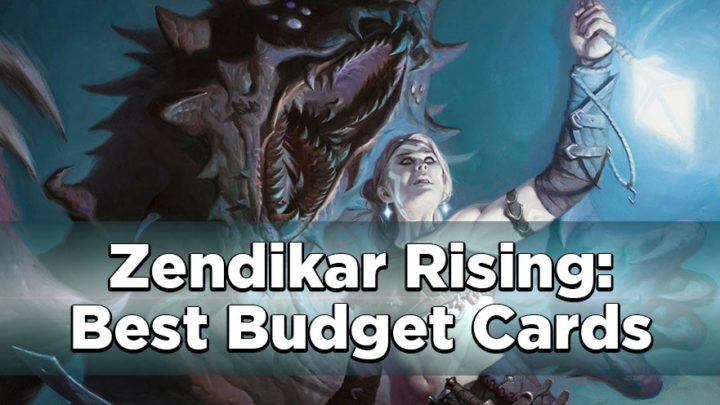Zendikar Rising is just upon us, and it’s looking to be a set that’s breaking new ground. Literally — it’s doing some weird new things with lands.
While this may be a lower-power set compared to others from the past year, it’s already proving to have many useful and flexible new toys for us to play with. Most of the cards that will see play from this set won’t spawn new archetypes or alter the landscape of eternal formats, but rather reinforce the options available to you as a deck builder and player.
This article is a detailed look at some of Zendikar Rising’s more affordable cards, focused on Pioneer and Modern — all with prices under $5. I’ll explain how they could impact different decks and strategies, and ultimately, how to get the most from your dollar. In fact, this set will be such good value, you’ll often get two cards in one!
While I love to talk at length about everything (especially Magic), there may be too many good cards in this set to talk about! Because of this, I’d like to start off with some Honorable Mentions. These are cards that are a little too niche or low-impact to make a strong impression.
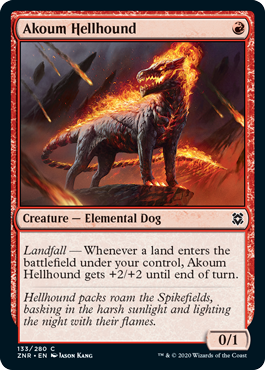
Akoum Hellhound – This card is actually really good, but it’s in the Honorable Mentions due to deck-building costs. Just like its white counterpart, Steppe Lynx, its landfall ability works best in combination with fetchlands, which will drive up the price of any deck featuring this card.
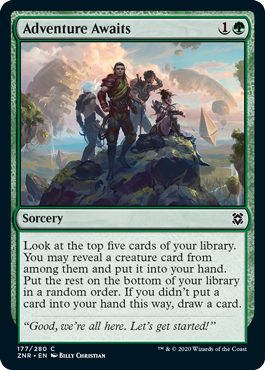
Adventure Awaits – Digging up to six cards is great, but spending two mana at sorcery speed to either grab a creature or take a blind draw just isn’t particularly strong in eternal formats.
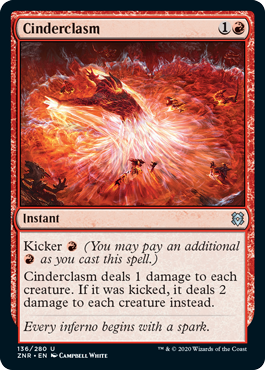
Cinderclasm – The choice between Electrickery or Volcanic Fallout is nice, but Kozilek’s Return, Anger of the Gods, or Flame Sweep will often serve you better.
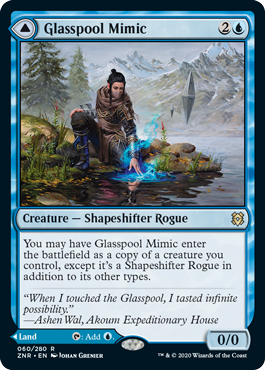
Glasspool Mimic – It’s no Phantasmal Image, but it’s much cheaper. It’s also a land in an emergency, so it has a different kind of flexibility compared to other Clones.
Bloodchief’s Thirst
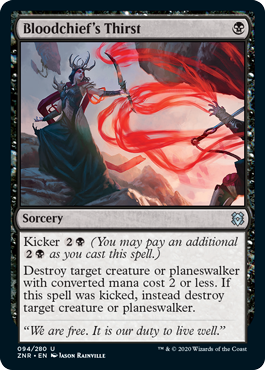
Every time a removal spell gets printed in a new set, it’s immediately compared to the other available options. In terms of Pioneer and Modern, there are several criteria it needs to pass to join the ranks alongside Fatal Push and Lightning Bolt. How much does it cost? Is it an instant? What can it kill? How flexible is it? While Bloodchief’s Thirst may be a sorcery, it is cheap, efficient, and can remove most threats.
It does have a weakness, however: if you need to remove a three-mana threat, you’ll have to use more resources to remove it than your opponent spent to cast it, and that’s not a winning strategy. Aside from that, it’s a decently flexible tool to have in your arsenal, particularly for Pioneer, which tends to be slightly slower than Modern.
Inscription of Ruin
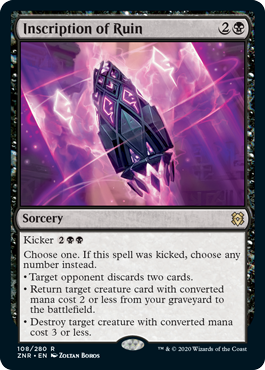
I’m a sucker for modal spells, particularly when at least one option is relevant in any given match-up. A couple of copies could easily show up in some of the grindy Rakdos Pyromancer decks in Pioneer, and it could even see similar use in Modern.
Wrench Mind, Unearth, and Eliminate may all be better at their individual functions, but a jack of all trades is often better than a master of one. The real kicker here (pun intended) is that this is an incredible late-game card, particularly in grindy match-ups; a single spell that can tear apart your opponent’s hand, remove a threat, and return a Young Pyromancer or Dreadhorde Arcanist can be back-breaking.
Silundi Vision
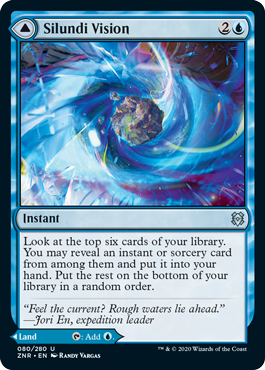
As a Twiddle Storm player, I’ve cast more than my fair share of Peer Through Depths. All too often, you’re looking for your next land drop, but you draw one of these narrow Impulse effects instead. For more land-light decks like Storm and Izzet Tempo/Spells strategies, having your spells double as mana sources in a pinch is extremely potent; these decks tend to perform terribly when they fall behind, so anything that helps to minimize the risk is very welcome. This may only show up as a one-of in some decks, but the increased consistency will be noticeable.
Hagra Mauling
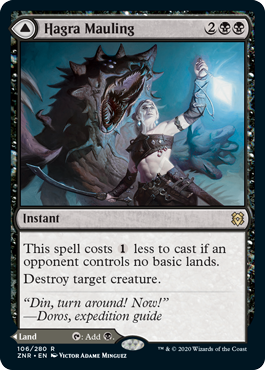
Murder is an unplayable card by today’s standards, to the point that you may be better off adding a land to your deck instead. But what if that land also came with the option of being a Murder? Suddenly, Hagra Mauling looks much better. It’s not an incredible card, but in those midrange or control decks where you’re unsure if you should add that extra land or make it a spell (spoiler alert: add the land), a card that gives you a mediocre version of both will fit nicely.
Jwari Disruption
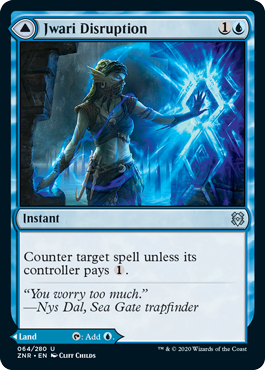
I wasn’t sold on this card at first and put it down to just being worse Censor. After playtesting with it, I’ve found it’s not worse, but different. This could easily see some play in draw-go control strategies as a way to either punish tapping out or ensure you hit your land drops so you can cast your sweeper in time.
This could also show up in blue-based midrange decks, too. The spell side is good on the play — many soft counters get better when you’re going first — but these effects are less likely to line up on the draw. This is where the land side will be most beneficial: ensuring you don’t miss your land drops and continuing to develop your board every turn is the best way to mitigate the downsides of not going first.
Skyclave Cleric
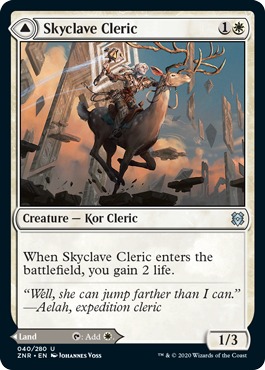
This innocuous little uncommon is a perfect example of the power of the new modal double-faced cards. Skyclave Cleric may not be the best anti-aggro card we’ve ever seen, but the land on its backside means that it’ll still be effective in slower games. This could see play in control decks as far back as Modern, with increased use in more aggressive metagames.
Malakir Rebirth
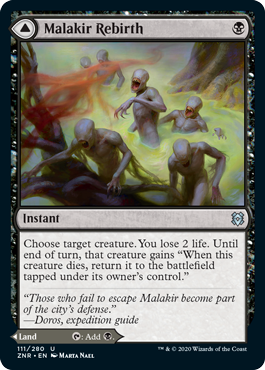
Similar effects have shown up in decks on occasion, either to protect a key creature from removal or to take advantage of sacrifice/death triggers. Malakir Rebirth is arguably the best of these spells to date — it costs just one mana, it’s an instant, and it’s also a land. I expect this to do some work in Pioneer, probably alongside Archfiend’s Vessel, as the prospect of creating a 5/5 flyer at instant speed for just one mana is quite exciting.
Feed the Swarm
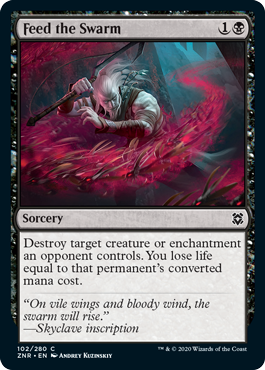
Enchantment removal in black is extremely rare, and it’s usually too restrictive or expensive. Thankfully, Feed the Swarm is neither. Life is an increasingly abusable resource the further into eternal formats you go — just look at Death’s Shadow in Modern and Legacy. The life lost from this spell will rarely matter, too; it will likely target Rest in Peace, Leyline of Sanctity, and Wilderness Reclamation, which are mostly present in decks that don’t tend to pressure your life total. Alongside Death’s Shadow decks, this can be used in 8-Rack, Mono-Black Aristocrats, and Mono-Black Aggro to great effect.
Sejiri Shelter
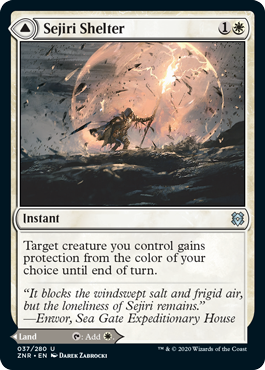
We all know how powerful cheap protection spells can be. Whether you’re protecting a key threat from removal, blowing opponents out in combat, or punching through hardened defenses, your opponents must be prepared to play around them.
One of the biggest achilles heels of aggressive decks is mana screw. If you have several three-drops in hand but never draw your third land, the game was ultimately decided by your belief in the heart of the cards. This can feel awful from a play experience perspective, but Sejiri Shelter may help going forward. A tapped land may be terrible in an aggressive deck, but it’s head and shoulders above a spell you can’t cast. I expect to see a couple copies in decks like Orzhov Humans or Azorius Spirits in Pioneer, even as a sideboard card.
Cleansing Wildfire
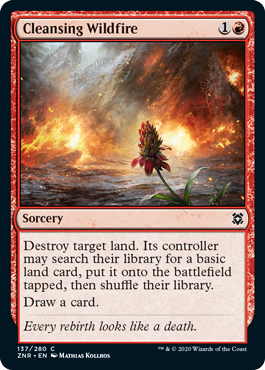
Usually, Stone Rain effects set your opponent back temporarily. You take out a land, then capitalize on your opponent’s tempo loss by deploying a massive threat to close the game quickly. Cleansing Wildfire is a little more nuanced than that, though. It’s not meant to cause a huge tempo loss a la Stone Rain, but rather to knock your opponent off just enough to take advantage. While the tempo loss may be smaller than with other land destruction spells, the lower mana cost and the card draw effect make this more effective against many different decks.
The obvious targets for this are Tron and Amulet Titan in Modern, though there are other great targets that run very few basics, like Death’s Shadow. The dream scenario is using this as a Sinkhole that cantrips, though even knocking an opponent off a color or denying them a utility land without losing a card is still a very decent play.
Bala Ged Recovery
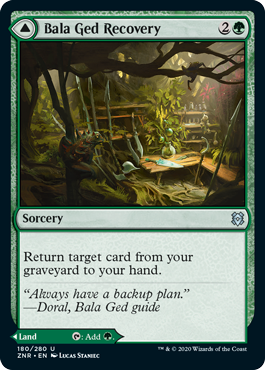
There has been some stir in the Magic community about this card already, and rightly so. In many situations, a card with a playable spell on one side and a passable land on the other becomes much greater than the sum of its parts.
There’s an increasing pressure to add more lands to decks; this helps guarantee that you can cast your haymakers on time, lest you risk falling behind. Not only does Bala Ged Recovery add more lands to your deck, but it also turns those lands into potent late-game top-decks. If you’re playing green, you should probably run at least one copy of this in your deck (at least in Pioneer).
Spikefield Hazard
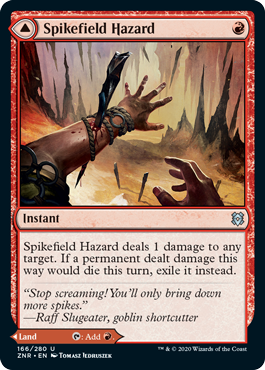
This is the card I’m actually most excited by. It looks so innocuous, but its applications are incredibly broad. A single point of damage might not seem like much, but it’s capable of dealing with much more than you may think. Apart from sniping low-loyalty planeswalkers, it can permanently deal with Dark Confidant, Young Pyromancer, Noble Hierarch, Bloodghast, Thalia, Guardian of Thraben, and Brazen Borrower, to name a few. It’s also worth noting that this can hit Uro, Titan of Nature’s Wrath while its sacrifice trigger is still on the stack, so it’ll get exiled instead!
The Pathway Lands
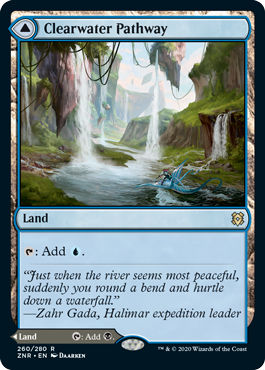
I wouldn’t usually include the rare cycle of lands from a set in my evaluations, as their power should be obvious, but it seems many people don’t believe they’re particularly good. In my opinion, they’re better than fast lands like Spirebluff Canal and Darkslick Shores, at least in most situations. Fast lands are only ever good in the first three turns of the game, and while they tend to be the most relevant turns in faster formats like Pioneer and Modern, games often go on much longer than that.
The Pathway lands are also going to give a huge boost to two-color aggressive decks in Pioneer, which are currently under-supported due to the absence of half the pain lands and fast lands. They will be a mainstay of Pioneer at the very least, and will serve as excellent additions to budget mana bases in Modern.
I’m sure you’ve spotted a trend in the majority of these cards: modality. The power of choice is not to be underestimated; increasing the number of choices available at the cost of a small amount of efficiency is incredibly powerful, and something that’s extremely easy to underestimate. Between the new affordable dual lands and many of the modal double-faced cards, the added flexibility should ultimately translate to more wins for us budget players.
This marks the end of my deep-dive into the budget cards from Zendikar Rising. Whether you’re looking to ration your hard-earned treasure during these tumultuous times, or you’re on a quest to brew the best build for your buck, I’m sure you’ll find something of value in Zendikar Rising.

Scott is an Irish content creator and the Head of Budget Magic for the Izzet League. He focuses on affordable decks in Pioneer, Modern, and Pauper, particularly ones that stray from the mainstream. When he’s not writing about his favorite decks, he can be found talking incessantly about them on Twitter and on The Budget Magic Cast.

